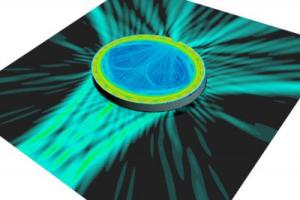Dec 14 2010
Utilizing a century-old phenomenon discovered in St. Paul's Cathedral, London, applied scientists at Harvard University have demonstrated, for the first time, highly collimated unidirectional microlasers.
The result of a collaboration with researchers from Hamamatsu Photonics in Hamamatsu City, Japan, and the Institute of Theoretical Physics of the University of Magdeburg, Germany, the advance has a wide range of new applications in photonics such as sensing and communications.
 The new microlaser uses an elliptical resonator with a wavelength-sized notch (seen at top right) on the boundary to create unidirectional rays (bottom left).
The new microlaser uses an elliptical resonator with a wavelength-sized notch (seen at top right) on the boundary to create unidirectional rays (bottom left).
Published online this week in the Proceedings of the National Academy of Sciences, the research team took advantage of a concept in physics referred to as "whispering gallery modes."
Over a century ago, British scientist Lord Rayleigh wondered how two people standing on opposite sides of the dome in St. Paul's Cathedral could hear each other by whispering into the circular wall. He discovered that the sound skirts along the smooth surface of the wall with negligible attenuation due to scattering or absorption.
The optical analog of whispers in a dome are light rays confined to the perimeter of tiny circular disks by multiple reflections from the boundary as they circle around. Because attenuation is minimal within the smooth disk, these resonators have already been used to make some of the world's lowest-threshold lasers. Circular disks, however, have posed certain challenges.
"One of the crucial unsolved problems of these microlasers for practical applications has been that their emission is non-directional and their optical power output is negligible," said team leader Federico Capasso, Robert L. Wallace Professor of Applied Physics and Vinton Hayes Senior Research Fellow in Electrical Engineering at Harvard's School of Engineering and Applied Sciences (SEAS).
"Light gets trapped by these whispering gallery modes with little chance to escape except by a faint isotropic emission. Strategies to suitably deform the disks to solve this problem have yielded disappointing results," Capasso added.
By shaping the microlaser as an ellipse with a wavelength-size notch carved out from its edge, Capasso's team found that the cycling whispering gallery modes scatter efficiently off the notch and emerge as nearly parallel beams from the microlaser.
The prototypes are quantum cascade lasers emitting an optical power of 5 milliwatts at a wavelength of 10 microns. The microlaser performance is insensitive to the details of the notch, making this device design very robust.
"Our calculations show that the notched elliptical microlaser should have even better performance at the shorter wavelengths near 1 micron, typical of laser diodes used in optical communications, where the attenuation of whispering gallery modes is negligible," said coauthor Jan Wiersig of the Institute of Theoretical Physics of the University of Magdeburg.
"The successful realization of these simple-structured and robust microlasers through standard wafer-based fabrication makes small-volume directional light sources possible for many important applications such as photonic integrated circuits with high-density chip-scale integration, optical communications, medical/biological sensors, and lab-on-a-chip," said coauthor Masamichi Yamanishi, Research Fellow of Central Research Laboratories at Hamamatsu.
Source: http://www.harvard.edu/